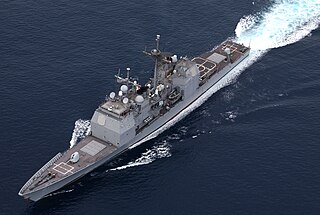
The Aegis Combat System is an American integrated naval weapons system, which uses computers and radars to track and guide weapons to destroy enemy targets. It was developed by the Missile and Surface Radar Division of RCA, and it is now produced by Lockheed Martin.

The Goalkeeper CIWS is a Dutch close-in weapon system (SEE-wiz) introduced in 1979. It is an autonomous and completely automatic weapon system for short-range defence of ships against highly manoeuvrable missiles, aircraft and fast-manoeuvering surface vessels. Once activated the system automatically undertakes the entire air defence process from surveillance and detection to destruction, including the selection of the next priority target.

The Type 45 destroyer, also known as the D or Daring class, is a class of six guided-missile destroyers built for the United Kingdom's Royal Navy in the early 21st century. The class is primarily designed for anti-aircraft and anti-missile warfare and is built around the PAAMS air-defence system using the SAMPSON Active electronically scanned array (AESA) and the S1850M long-range radars. The first three destroyers were assembled by BAE Systems Surface Fleet Solutions from partially prefabricated "blocks" built at different shipyards; the remaining three were built by BAE Systems Maritime – Naval Ships. The first ship in the Daring class, HMS Daring, was launched on 1 February 2006 and commissioned on 23 July 2009.

The Aster 15 and Aster 30 are a Franco-Italian family of all-weather, vertical launch surface-to-air missiles. The name "Aster" stands for "Aérospatiale Terminale", with French company Aérospatiale having been the project's lead contractor before its missile activities were merged into MBDA. It also takes inspiration from the word "aster", meaning "star" in Ancient Greek. The missiles as well as the related weapon systems are manufactured by Eurosam, a consortium consisting of MBDA France, MBDA Italy, both with a combined 66% share, and Thales holding 33%.

The Queen Elizabeth-class aircraft carriers of the United Kingdom's Royal Navy consists of two vessels. The lead ship of her class, HMS Queen Elizabeth, was named on 4 July 2014 in honour of Elizabeth I and was commissioned on 7 December 2017. Her sister ship, HMS Prince of Wales, was launched on 21 December 2017, and was commissioned on 10 December 2019. They form the central components of the UK Carrier Strike Group.

The Principal Anti-Air Missile System (PAAMS) is a joint programme developed by France, Italy, and the United Kingdom for an integrated anti-aircraft warfare system. The prime contractor is EUROPAAMS, a joint venture between Eurosam (66%) and UKAMS (33%). In the United Kingdom, PAAMS has been given the designation Sea Viper.

The Horizon class (French: Classe Horizon; Italian: Classe Orizzonte) is a class of air-defence destroyers in service with the French and Italian navies. They are designated as destroyers by the Italians and using NATO classification but are referred to as "frigates" by the French. The programme started as the Common New Generation Frigate (CNGF), a three-nation collaboration between France, the United Kingdom, and Italy to develop a new generation of air-defence warships. Differing national requirements, workshare disagreements and delays led to the UK withdrawing from the project in 1999 to develop the Type 45 destroyer.

The SAMPSON is a multi-function dual-face active electronically scanned array radar produced by BAE Systems Maritime. It is the fire control radar component of the Sea Viper naval air defence system. The Sea Viper system is also known as PAAMS(S) to denote the use of the SAMPSON radar and to distinguish it from the PAAMS system on the Franco-Italian Horizon-class frigate.
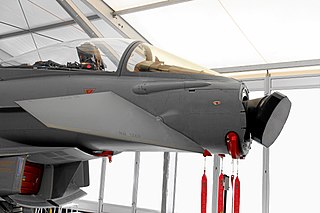
An active electronically scanned array (AESA) is a type of phased array antenna, which is a computer-controlled array antenna in which the beam of radio waves can be electronically steered to point in different directions without moving the antenna. In the AESA, each antenna element is connected to a small solid-state transmit/receive module (TRM) under the control of a computer, which performs the functions of a transmitter and/or receiver for the antenna. This contrasts with a passive electronically scanned array (PESA), in which all the antenna elements are connected to a single transmitter and/or receiver through phase shifters under the control of the computer. AESA's main use is in radar, and these are known as active phased array radar (APAR).
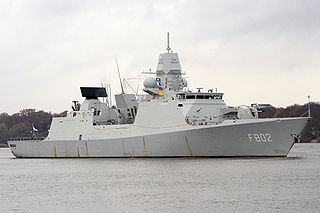
HNLMS De Zeven Provinciën (F802) is the first ship of the De Zeven Provinciën-class air defence and command frigates in service with the Royal Netherlands Navy (RNLN). There are three other ships in this class, HNLMS Tromp, HNLMS De Ruyter, and HNLMS Evertsen. De Zeven Provinciën is the eighth ship in the Royal Netherlands Navy to carry this name. The name refers to the original seven Dutch provinces which together formed the Union of Utrecht.
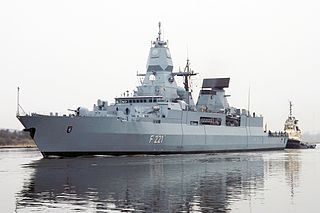
The F124 Sachsen class is the German Navy's latest class of highly advanced air-defense frigates. The design of the Sachsen-class frigate is based on that of the F123 Brandenburg class but with enhanced stealth features designed to deceive an opponent's radar and acoustic sensors. The class incorporates an advanced multifunction radar APAR and a SMART-L long-range radar which is purported to be capable of detecting stealth aircraft and stealth missiles.

The four De Zeven Provinciën-class frigates are air-defence and command frigates in service with the Royal Netherlands Navy. This class of ships is also known as "LCF". The ships are similar to the German Sachsen-class frigates in role and mission.
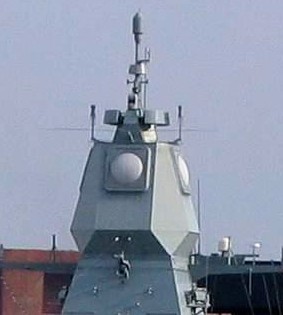
Active Phased Array Radar (APAR) is a shipborne active electronically scanned array multifunction 3D radar (MFR) developed and manufactured by Thales Nederland. The radar receiver modules are developed and built in the US by the Sanmina Corporation.
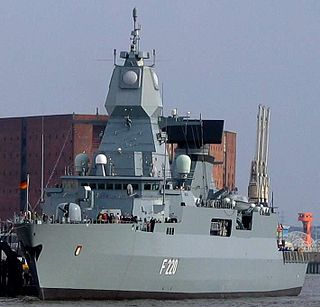
SMART-L is a long-range naval search radar introduced in 2002 by Thales Nederland, formerly Hollandse Signaalapparaten (Signaal).

Eurosam GIE is a European manufacturer of anti-air missiles. Eurosam was established in June 1989 for the development of the Famille de missiles Sol-Air Futurs. Eurosam was initially a joint venture between Aérospatiale, Alenia and Thomson-CSF. Now Aérospatiale is a part of MBDA, and Missile and Missile Systems activities of Alenia are now the Italian branch of MBDA. Thomson CSF is now the Thales Group. Thus Eurosam is owned by MBDA France and MBDA Italy as well as Thales Group (33%).

The AN/SPY-6 is an active electronically scanned array 3D radar under development for the United States Navy (USN). It will provide integrated air and missile defense for Flight III Arleigh Burke-class destroyers. Variants are under development for retrofitting Flight IIA Arleigh Burkes and for installation aboard Constellation-class frigates, Gerald R. Ford-class aircraft carriers, and San Antonio-class amphibious transport docks.

The AN/SPY-1 is a United States Navy 3D radar system manufactured by Lockheed Martin. The array is a passive electronically scanned system and a key component of the Aegis Combat System. The system is computer controlled and uses four complementary antennas to provide 360-degree coverage. The system was first installed in 1973 on USS Norton Sound and entered active service in 1983 as the SPY-1A on USS Ticonderoga. The -1A was installed on ships up to CG-58, with the -1B upgrade first installed on USS Princeton in 1986. The upgraded -1B(V) was retrofitted to existing ships from CG-59 up to the last, USS Port Royal.

EMPAR is a rotating C band multifunction passive electronically scanned array radar that reached IOC in 2006 and was initially built by Selex ES. It is designed to be the principal radar system aboard naval vessels of medium and large sizes. The radar offers full volumetric search coverage, low altitude and surface search, the tracking of multiple targets, and the capability to uplink information for missile guidance.

SMART-S Mk2(Signaal Multibeam Acquisition Radar for Tracking, S band Mk2) is a naval medium to long-range air and surface surveillance multibeam passive electronically scanned array 3D radar designed by Thales Nederland, formerly Hollandse Signaalapparaten (Signaal). While the original SMART-S radar was only produced in small numbers, SMART-S Mk2 is very successful. Only six years after its introduction, 30 systems were sold to navies all over the world. SMART-S Mk2 radar is equipped with transmitter/receiver (T/R) modules manufactured by Turkish defence company Aselsan. The radar transmitter/receiver (T/R) modules for the radar are purchased by Thales from Aselsan.
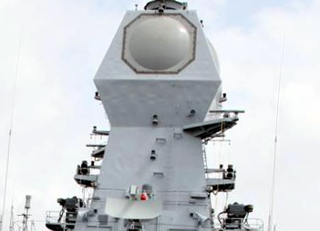
The EL/M-2248 MF-STAR is a multifunction active electronically scanned array naval radar system developed by IAI Elta for maritime installation on warships. It is capable of tracking both air and surface targets and providing fire control guidance. MF-STAR is an acronym of Multi-Function Surveillance, Track And Guidance Radar.




















